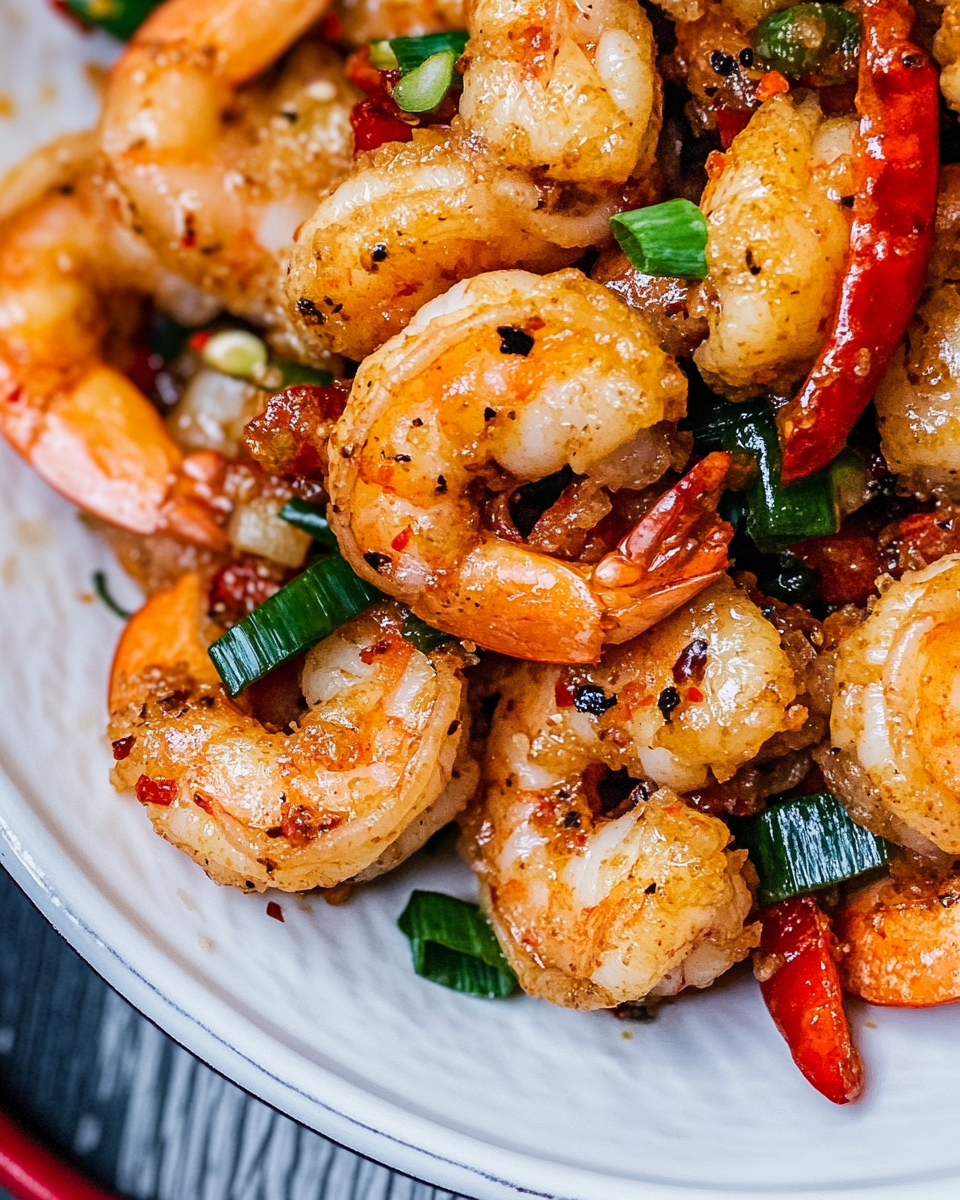A quick and irresistible dish, Spicy Salt and Pepper Shrimp offers a crunchy texture with a punch of bold, spicy flavors. Perfect as an appetizer or a snack, these shrimp are lightly battered, fried to golden perfection, and tossed with aromatic spices that awaken your taste buds.
FULL RECIPE
Ingredients
- 1 lb large shrimp, peeled and deveined
- 1/2 cup all-purpose flour
- 1/4 cup cornstarch
- 1 tsp baking powder
- 1/2 tsp salt
- 1/4 tsp black pepper
- 1/2 tsp white pepper
- 1/2 tsp chili powder or cayenne pepper (adjust to taste)
- 2 cloves garlic, minced
- 1 small red chili, sliced (optional for extra heat)
- 2 green onions, chopped
- Vegetable oil, for frying
- Lemon wedges, for serving
Directions
- In a bowl, mix the flour, cornstarch, baking powder, salt, black pepper, white pepper, and chili powder.
- Add the shrimp and toss to coat evenly.
- Heat oil in a deep pan or wok over medium-high heat. Fry shrimp in batches until golden and crispy, about 2-3 minutes per batch. Drain on paper towels.
- In a separate pan, heat a tablespoon of oil and sauté the garlic, sliced chili, and green onions until fragrant, about 1 minute.
- Add the fried shrimp back into the pan and toss well to combine with the aromatics and spices.
- Serve immediately with lemon wedges on the side.
Nutritional Information
- Calories: 280 kcal
- Protein: 25 g
- Fat: 14 g
- Saturated Fat: 2.5 g
- Carbohydrates: 15 g
- Fiber: 1 g
- Sugar: 0.5 g
- Sodium: 620 mg
- Cholesterol: 190 mg
Origins and Cultural Significance of Salt and Pepper Shrimp
Salt and pepper shrimp is a beloved dish originating from Chinese cuisine, particularly popular in Cantonese cooking. This recipe reflects the classic technique of frying seafood with a light, crispy coating while seasoning it simply but powerfully with salt, black pepper, and sometimes chili. The dish celebrates the natural sweetness of shrimp enhanced by the contrast of heat and saltiness, making it a staple in Chinese restaurants worldwide and a popular choice for home cooks seeking a flavorful yet straightforward seafood appetizer.
The Science Behind the Crunchy Texture
The signature crunchiness of salt and pepper shrimp comes from a carefully balanced batter made with cornstarch and flour. Cornstarch is key to achieving a light and crispy coating because it creates a delicate crust that crisps up quickly without absorbing too much oil. The combination with baking powder introduces tiny bubbles during frying, adding to the lightness of the coating. This crunchy texture contrasts beautifully with the tender shrimp inside, creating an enjoyable mouthfeel.
How to Select the Best Shrimp for This Recipe
Choosing the right shrimp is essential for the best flavor and texture. Large, fresh shrimp or high-quality frozen shrimp with shells removed and deveined work best. Freshness is crucial, as shrimp can quickly lose flavor and develop a fishy smell if not stored properly. Look for shrimp with firm flesh and a mild, ocean-like scent. If using frozen shrimp, thaw them gently in the refrigerator or under cold running water to maintain texture.
The Role of Spices in Enhancing Flavor
Salt and pepper shrimp rely heavily on the right balance of spices. The foundational ingredients are salt and black pepper, which provide seasoning and a mild heat. White pepper adds a slightly different spicy note that complements black pepper without overwhelming it. Chili powder or cayenne pepper introduces a sharp heat that can be adjusted to taste, making the dish versatile for mild or spicy preferences. The fresh garlic and sliced chili peppers further layer the flavors, adding aromatic depth and complexity.
Techniques for Perfect Deep Frying
Achieving the perfect fry requires proper temperature control and technique. The oil should be heated to around 350°F (175°C) to ensure the shrimp cooks quickly and evenly without absorbing excess oil. Frying in small batches prevents the oil temperature from dropping and helps maintain crispiness. Using a deep pan or wok allows even heat distribution and sufficient oil depth to submerge the shrimp. Draining the shrimp on paper towels after frying removes excess oil, keeping the dish light.
Health Considerations and Nutritional Aspects
While fried dishes are often seen as indulgent, salt and pepper shrimp can fit into a balanced diet when enjoyed in moderation. Shrimp itself is a low-calorie, high-protein seafood rich in essential nutrients like selenium, vitamin B12, and omega-3 fatty acids. However, the frying process adds fat and calories, so using healthier oils and controlling portion size can make this dish a more nutritious choice. Additionally, the seasoning is typically low in sugar and carbohydrates, making it compatible with many dietary plans.
Pairing Salt and Pepper Shrimp with Side Dishes
This dish shines when paired with complementary sides that balance its bold flavors. Simple steamed jasmine rice or fried rice offers a neutral base to soak up the savory spices. Light vegetable stir-fries, such as bok choy or snap peas, provide freshness and crunch that contrast nicely with the fried shrimp. For a refreshing touch, a cucumber salad or pickled vegetables can cleanse the palate and add acidity. These pairings make the meal well-rounded and satisfying.
Variations and Adaptations Around the World
Salt and pepper shrimp has inspired numerous variations across different cuisines. In some adaptations, additional spices like five-spice powder or Sichuan peppercorns are added for complexity and numbing heat. Other versions might incorporate dipping sauces such as sweet chili or soy-based mixtures to enhance flavor. The batter can be altered to include rice flour or tempura flour for different textures. Some cooks even grill or bake the shrimp for a healthier twist, maintaining the essential salt and pepper seasoning.
Tips for Storing and Reheating Leftovers
If you have leftovers, storing and reheating properly will preserve the best texture and flavor. Keep the shrimp in an airtight container in the refrigerator for up to two days. To reheat, avoid the microwave as it can make the coating soggy. Instead, reheat in a preheated oven at 350°F (175°C) for 5-7 minutes or in a hot skillet with a little oil to crisp the coating again. Avoid overcooking to maintain the shrimp’s juiciness.
The Appeal of Salt and Pepper Shrimp in Modern Dining
This dish’s popularity in both casual and upscale dining reflects its versatility and crowd-pleasing taste. Salt and pepper shrimp fits well on party menus as a finger food, in family dinners as a quick entrée, or in fusion cuisine where traditional flavors meet contemporary twists. Its combination of simple ingredients with bold seasoning makes it accessible to cooks of all skill levels while delivering restaurant-quality results.
Environmental and Sustainability Considerations
As with all seafood, choosing shrimp from sustainable sources is important to reduce environmental impact. Overfishing and destructive farming practices have threatened shrimp populations and ecosystems. Look for certifications like those from the Marine Stewardship Council (MSC) or aquaculture operations that follow responsible practices. Supporting sustainable shrimp helps protect marine biodiversity and ensures this delicious dish remains available for future generations.
The Influence of Salt and Pepper Shrimp on Home Cooking Trends
Salt and pepper shrimp has inspired home cooks worldwide to explore Asian flavors and frying techniques. Its quick preparation and impressive flavor profile encourage experimentation with spices and batter variations. Many home chefs incorporate this recipe into their regular rotation as a go-to appetizer or main dish, showcasing how traditional recipes can become modern favorites that bridge cultural culinary boundaries.
Conclusion
Spicy salt and pepper shrimp is much more than just a fried seafood dish; it is a celebration of texture, flavor, and culinary tradition. From its origins in Chinese cuisine to its widespread appeal, this recipe combines simple ingredients with skillful techniques to create a crunchy, flavorful bite that delights the palate. Whether enjoyed as an appetizer at a festive gathering or a quick weeknight treat, salt and pepper shrimp’s bold seasoning and satisfying crunch make it a timeless favorite. With attention to ingredient quality, frying technique, and sustainable sourcing, this dish offers both indulgence and nourishment, embodying the best of home-cooked Asian-inspired cuisine.








